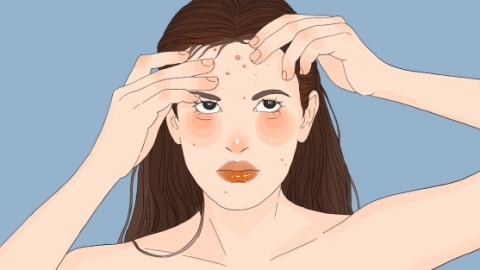What are the symptoms of a damp-heat constitution?
Physical manifestations caused by a damp-heat constitution generally include bodily heaviness and fatigue, oily skin with acne, bitter taste and stickiness in the mouth with bad breath, sticky and unsatisfactory bowel movements, and short, dark yellow or reddish urine. The specific symptoms are as follows:

1. Bodily heaviness and fatigue: Accumulation of internal dampness and heat hinders the circulation of qi and blood, often causing a feeling of heaviness in the body, similar to being wrapped in wet cloth. This sensation persists even after sufficient sleep and fails to relieve fatigue. During physical activity, limbs feel weak, mental state tends to be listless, and it becomes difficult to concentrate.
2. Oily skin with acne: Damp-heat reaches the skin through the meridians, stimulating excessive sebum production. The face and scalp become oily, particularly noticeable on the forehead and sides of the nose. Acne and pimples develop easily, some accompanied by redness, swelling, and pus. Occasional skin itching may occur, and scratching may leave marks.
3. Bitter taste, sticky mouth, and bad breath: Damp-heat rising upward affects the oral cavity, causing a bitter taste in the mouth upon waking or in the afternoon. There is a persistent sticky sensation inside the mouth that cannot be completely eliminated even after brushing teeth. Bad breath is also present, easily noticeable during close conversations. Symptoms worsen after consuming spicy or greasy foods.
4. Sticky and unsatisfactory bowel movements: Damp-heat descending into the intestines affects intestinal motility, causing sticky and poorly formed stools. Bowel movements tend to stick to the toilet bowl and are difficult to flush away. The defecation process feels unsmooth, often accompanied by a sensation of incomplete evacuation. Some individuals experience prolonged bowel movements and a sticky residue around the anus after defecation.
5. Short, dark yellow or reddish urine: Internal damp-heat affects fluid metabolism, interfering with urine production and excretion. Urine volume decreases and appears deep yellow or tea-colored. A mild burning sensation may occur during urination, and the first urination in the morning shows darker, shorter, and more concentrated urine.
After experiencing symptoms related to a damp-heat constitution, it is important to maintain a light diet, reduce intake of spicy, sweet, and fried foods, and consume more heat-clearing and dampness-resolving foods such as coix seed, winter melon, and mung beans. Additionally, maintaining regular sleep patterns, avoiding late nights, and engaging in moderate physical activity to promote sweating are recommended.





